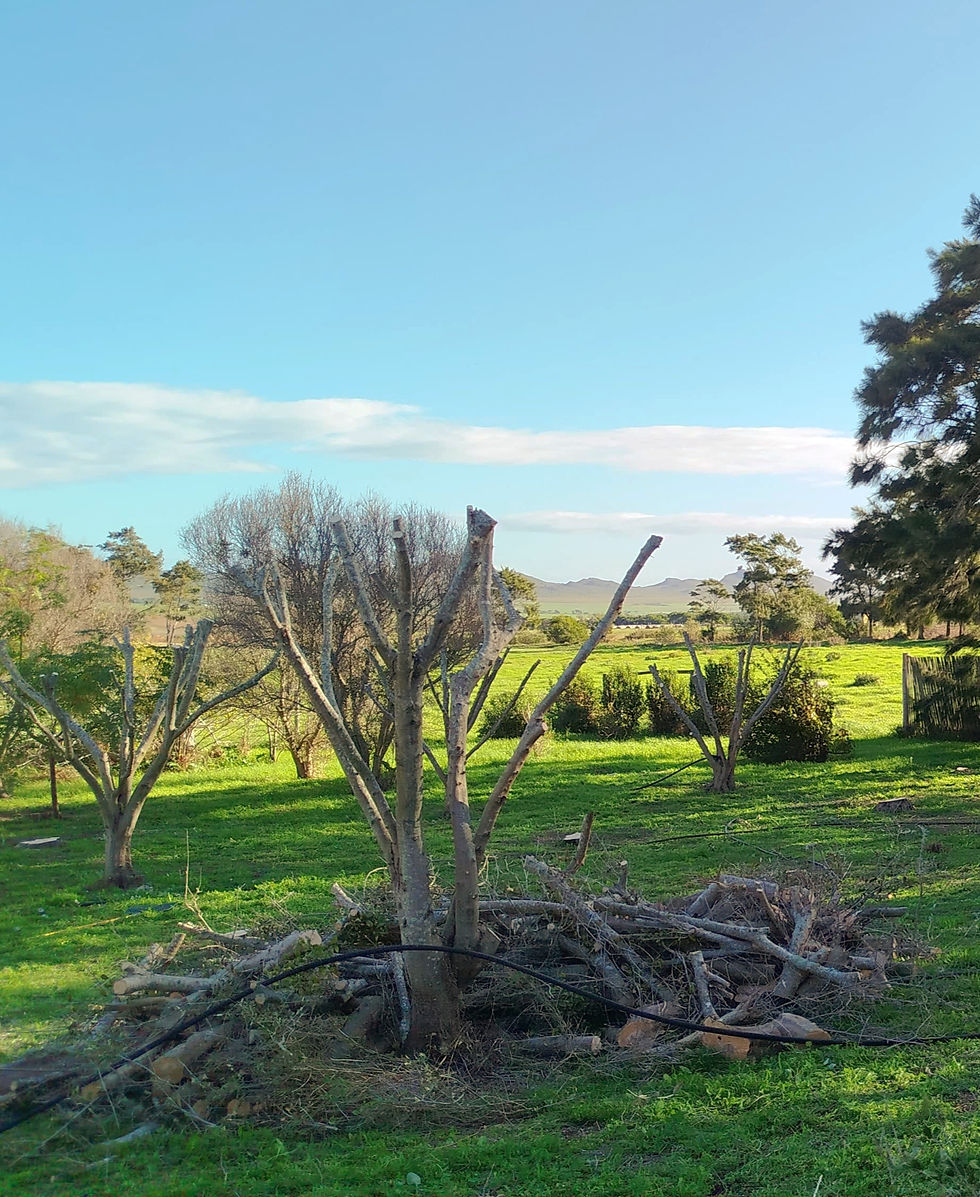What Does Sustainable Waste Management Look Like in Arboriculture — and Why Should It Matter?
- Marne Truter
- Aug 6
- 4 min read
Updated: Sep 9
Waste isn’t just about what goes to the landfill. In our world, it’s about what’s left behind after the chainsaws stop and the wood chipper cools.
At Overberg Arborists, we work with trees, living systems that give far more than they take. So when we prune, remove, or process tree material, we think beyond the job. We think about where that material ends up, what it becomes, and how we can close the loop.
This is what sustainable waste management means to us. It’s not a nice-to-have, it’s a responsibility. One that affects your property, our environment, and the future of the Overberg’s natural systems.
In this guide, we unpack what sustainable waste management actually looks like in tree care, what goes wrong in conventional approaches, and how to do it right, whether you’re a landowner, homeowner, or just someone who doesn’t want to see another skip full of potential turned into landfill.

What Is Sustainable Waste Management in Tree Work?
In simple terms, it’s the process of handling organic tree waste in a way that benefits, rather than burdens, the ecosystem.
That means:
Reducing unnecessary waste
Reusing viable materials
Recycling biomass in useful ways
Composting what can break down
Avoiding sending everything to landfill “just to get it done”
This applies whether we’re trimming hedges or removing a full-grown Eucalyptus. There’s always a better way than dumping.
What Happens to Tree Waste in Most Jobs?
Unfortunately, here’s the reality:
Common Practice | The Problem |
Burning on-site | Releases CO₂ and pollutants, especially harmful in fire-prone areas |
Hauling to landfill | Expensive, inefficient, and wasteful of organic matter |
Leaving in piles | Can attract pests, smother vegetation, or leach into soil |
Ignoring invasive regrowth | Some invasives coppice aggressively if not properly handled |
It might be “cleaned up” — but where does it go? And what else could it have been?

What Should Happen Instead?
1. Chipping and Reuse On-Site
If the wood is clean (no pathogens, no invasives), mulch it.
Wood chips:
Regulate soil moisture
Reduce weed growth
Feed soil microbes
Provide erosion control
Look tidy and intentional
Mulch from your own trees = functional, and keeps the nutrients on your land.
2. Separating Invasives and Diseased Wood
Some material shouldn’t be mulched or reused, and this is where many contractors go wrong.
At Overberg Arborists, we separate:
Diseased branches (e.g. shot hole borer-infected wood)
Seed-heavy biomass (e.g. acacia pods, syringa berries)
These are either composted at high temperatures or responsibly incinerated via licensed waste routes to prevent spread or regrowth.
3. Log Reuse and Biomass Products
Larger pieces? Don’t waste them.
Options include:
Milling into slabs or planks for furniture, fencing, or firewood
Turning logs into habitat piles or hügelkultur (biodiversity hotspots)
Carving or landscaping features
Supplying them to biomass users (like woodchip boilers or mushroom farms)
If a tree was removed, at least let its biomass serve a new purpose.

What Do We Do With Tree Waste at Overberg Arborists?
We follow a tiered approach, nothing is wasted without a reason.
Step 1: On-site Use
We chip and redistribute mulch where possible
Homeowners often ask us to leave chipped material for garden beds
Step 2: Separation and Classification
We identify clean vs. invasive vs. diseased material
Anything that poses a risk is isolated and handled according to regulation
Step 3: Strategic Disposal or Repurposing
Invasives = taken to approved green waste sites or destroyed, used for firewood (where possible)
Large timber = stored for repurposing, biomass, or client reuse
Step 4: Communication With Clients
We explain the waste plan upfront
You know where your tree material is going, and why
We don’t charge blindly for “removal”, we account for ecological impact.
What Can Property Owners Do?
Whether you manage a single garden or a multi-hectare farm, you can make better waste decisions. Here’s how:
Ask your arborist the right questions:
“What happens to the tree waste?”
“Can you leave the mulch behind?”
“Is anything invasive or diseased in this pile?”
“Can any of the wood be reused on-site?”
If the contractor doesn’t know or doesn’t care, consider that a red flag.

Designate on-site waste zones:
A mulch pile for redistribution
A temporary log holding area
A composting corner for leaf litter
Even small gardens can find space to reuse biomass properly.
Educate staff, gardeners, or maintenance crews:
We’ve seen perfectly good mulch or logs removed by someone who “thought it was rubbish.” Keep everyone on the same page.
Why It Matters in the Western Cape
We’re not just managing waste, we’re shaping landscapes in a province that:
Faces increasing drought
Struggles with soil degradation
Hosts numerous invasive tree species
Needs more canopy and biodiversity, not less
Sustainable waste management contributes to:
Water conservation (via mulching)
Fire risk reduction (by clearing debris properly)
Soil regeneration (through compost and ground cover)
Habitat restoration (via thoughtful reuse of logs and branches)
And when you remove invasive trees responsibly, you create space for indigenous species to reclaim their place.
Waste Isn’t Waste if You Know What to Do With It
Tree waste is only waste if you treat it like trash. Handled properly, it’s mulch, soil food, erosion control, firewood, shelter, and structure.
Sustainable tree care doesn’t end with the chainsaw or pruning shears. It ends with what’s left, and how that material can go back into the land it came from.
At Overberg Arborists, we don’t do shortcuts. We plan for the full cycle, from cut to clean-up to soil restoration, and we help our clients do the same.





Comments